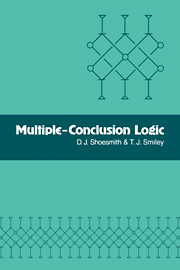Book contents
13 - Many–valued calculi
Published online by Cambridge University Press: 06 July 2010
Summary
Definitions
A propositional calculus satisfies two conditions, one on its formulae and the other on its consequence relation. The first condition postulates the existence of a countably infinite set of atomic formulae, traditionally called propositional variables, together with a finite number of connectives each of some specified valency (singulary, binary, k-ary, etc.). Each propositional variable is to be a formula, and if F is a k-ary connective and A1,…,Ak, are formulae then FA1…Ak, is to be a formula. Conversely every formula must admit a unique finite decomposition in terms of the variables and connectives. As long as this condition is met it does not matter what the propositional variables are, and we use p, q, etc. to stand for unspecified propositional variables. The notation FA1…Ak, is likewise a metalinguistic one, intended to cover a variety of notations (Polish, Russellian, etc.) by which the application of a connective can be expressed in particular calculi. In giving actual examples of calculi we assume a Russellian notation for them, and sometimes use dots to replace parentheses, e.g. A⊃.A⊃.A⊃B for A⊃(A⊃(A⊃B)). We write this formula also as A⊃3 B and define A⊃nB similarly for other n.
The second condition on a propositional calculus is that consequence must be closed under substitution. A substitution s is any mapping of formulae into formulae such that s(FA1…Ak) = Fs(A1)…,s(Ak). Every mapping of the propositional variables into the formulae thus determines a substitution and vice versa.
Information
- Type
- Chapter
- Information
- Multiple-Conclusion Logic , pp. 245 - 255Publisher: Cambridge University PressPrint publication year: 1978
